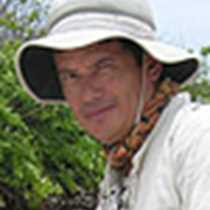Floreana Island
Floreana is famous because it is considered the most mysterious island in Galápagos. We felt a halo of mystery when we arrived, because the island was cloudy and accompanied by a tenuous garua. Early in the morning we disembarked at Post Office Bay, whose barrel has witnessed many historical facts, receiving in its interior letters of very famous sailors, whalers and pirates many years ago. Today our guests collected letters and postcards from the barrel to repeat the same hand delivered procedure.
After breakfast, we began one of the most beautiful Zodiac rides around the small islet of Champion. We set out to find the almost extinct Floreana mockingbird. It was the predation of introduced feral cats and rats; these animals were the reason these birds had to fly up to this small islet, being now its last refuge. Very far from the Zodiac, we saw a small group of mockingbirds on the top of opuntia cacti and trees.
On the vertical walls of the small islet we could see a group of red billed tropical birds that were nesting inside of fissures, leaving out their long tails or in other cases their red beak. Beyond, a group of swallowed tailed gulls slept pleasantly after a long night fishing (this species of gull is a nocturnal one). The water was transparent which enticed most of our guests to go deep water snorkeling. It was incredible; we swam for about an hour with juvenile sea lions. They followed us, inviting us to play with them and repeat their movements. It was really incredible.
In the afternoon, the kayaking was excellent. In front of the greenish beach of Punta Cormorant, we saw many marine turtles, marine wolves, blue-footed boobies and lava herons feeding on small mullets. The sea was very calm and perfect for all of our guests to have an enjoyable experience.
At 4PM we disembarked at Punta Cormorant and began to walk along this beautiful green beach looking for olivina, the green mineral that gave the color to this beautiful beach. We found many different sizes and textures. A small distance from the beach, was the lagoon of the greater flamingos; we found some adults and juveniles, but all of them with their heads in the muddy bottom of the lagoon. It is very rare to see this bird fly.
Leaving the first beach and then the flamingos, we arrived at a white beach. This, on the contrary does not contain olivine, instead it contains organic material, composed mainly of corals, shells and bones of animals. In the water, a group of sting rays swam close to the beach showing us their blackish color and their long tails. Farther, a group of sea turtles waited their turn to leave the sea and come to the beach at night to lay their eggs. From this beach, we could see the small islet of Champion, and behind of us, the majestic Pajas Hill, the highest point on Floreana Island. It was darker and colder, but that did not matter as the youngest of our guests swam and played on the sand up until the last ray of sun reminded us it was time to go back to the National Geographic Islander. We went back tired, but at the same time happy, because it was another wonderful day.
Call +1.800.397.3348 or contact your travel advisor




